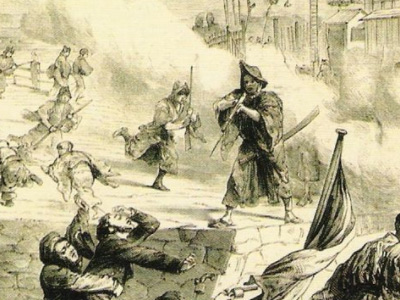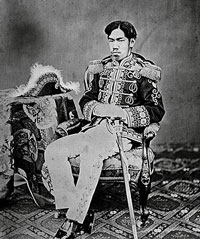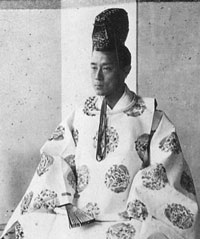Boshin War (1868-1869)
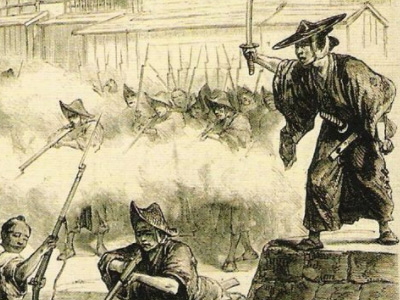
Opening Conflicts
On 27 January 1868, Shogunate forces attacked the forces of Chōshū and Satsuma, clashing near Toba and Fushimi, at the southern entrance of Kyoto. Some parts of the 15,000-strong Shogunate forces had been trained by French Second French Empire was the 18-year Imperial Bonapartist regime of Napoleon III from 14 January 1852 to 27 October 1870. The Second Empire is given high credit for the rebuilding of Paris with broad boulevards, striking public buildings, and elegant residential districts for upscale Parisians. In international policy, Napoleon III tried to emulate his uncle Napoleon I, engaging in numerous imperial ventures around the world as well as several wars in Europe. military advisers, but the majority remained medieval samurai forces. Of those samurai forces there were the Shinsengumi. Meanwhile, the forces of Chōshū and Satsuma were outnumbered 3:1 but fully modernized with Armstrong howitzers, Minié rifles and a few Gatling guns. After an inconclusive start, on the second day, an Imperial banner was remitted to the defending troops, and a relative of the Emperor, Ninnajinomiya Yoshiaki, was named nominal commander in chief, making the forces officially an imperial army (官軍 kangun). Moreover, convinced by courtiers, several local daimyōs, up to this point faithful to the Shogun, started to defect to the side of the imperial court. These included daimyōs of Yodo on February 5, and the daimy-o of Tsu on February 6, tilting the military balance in favour of the Imperial side.
Second French Empire was the 18-year Imperial Bonapartist regime of Napoleon III from 14 January 1852 to 27 October 1870. The Second Empire is given high credit for the rebuilding of Paris with broad boulevards, striking public buildings, and elegant residential districts for upscale Parisians. In international policy, Napoleon III tried to emulate his uncle Napoleon I, engaging in numerous imperial ventures around the world as well as several wars in Europe. military advisers, but the majority remained medieval samurai forces. Of those samurai forces there were the Shinsengumi. Meanwhile, the forces of Chōshū and Satsuma were outnumbered 3:1 but fully modernized with Armstrong howitzers, Minié rifles and a few Gatling guns. After an inconclusive start, on the second day, an Imperial banner was remitted to the defending troops, and a relative of the Emperor, Ninnajinomiya Yoshiaki, was named nominal commander in chief, making the forces officially an imperial army (官軍 kangun). Moreover, convinced by courtiers, several local daimyōs, up to this point faithful to the Shogun, started to defect to the side of the imperial court. These included daimyōs of Yodo on February 5, and the daimy-o of Tsu on February 6, tilting the military balance in favour of the Imperial side.
On February 7, Tokugawa Yoshinobu, apparently distressed by the imperial approval given to the actions of Satsuma and Chōshū, fled Osaka aboard the Kaiyō Maru, withdrawing to Edo. Demoralized by his flight and by the betrayal by Yodo and Tsu, Shogunate forces retreated, making the Toba-Fushimi encounter an Imperial victory, although it is often considered the Shogunate forces should have won the encounter. Osaka Castle was soon invested on February 8 (on March 1, Western calendar), putting an end to the battle of Toba-Fushimi.
At the same time, on 28 January 1868, the naval Battle of Awa between the Shogunate and elements of the Satsuma Navy took place. This was Japan's second engagement between two modern navies. The battle, although small in scale, ended in favour of the Shogunate.
On the diplomatic front, the ministers of foreign nations, gathered in the open harbor of Hyōgo (present day Kobe) in early February, issued a declaration according to which the Shogunate was still considered the only rightful government in Japan, giving hope to Tokugawa Yoshinobu that foreign nations (especially France) might consider an intervention in his favour. A few days later however an Imperial delegation visited the ministers declaring that the Shogunate was abolished, that harbours would be open in accordance with International treaties, and that foreigners would be protected. The ministers finally decided to recognize the new government.
The rise of anti-foreign sentiment nonetheless led to several attacks on foreigners in the following months. Eleven French sailors from the corvette Dupleix were killed by samurai of Tosa in the Sakai incident on March 8, 1868. Fifteen days later, Sir Harry Parkes, the British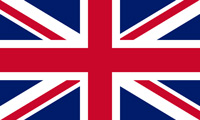 The United Kingdom of Great Britain and Ireland was a sovereign state in Northwestern Europe that comprised the entirety of the British Isles between 1801 and 1922. The United Kingdom, having financed the European coalition that defeated France during the Napoleonic Wars, developed a large Royal Navy that enabled the British Empire to become the foremost world power for the next century. ambassador, was attacked by a group of samurai in a street of Kyoto.
The United Kingdom of Great Britain and Ireland was a sovereign state in Northwestern Europe that comprised the entirety of the British Isles between 1801 and 1922. The United Kingdom, having financed the European coalition that defeated France during the Napoleonic Wars, developed a large Royal Navy that enabled the British Empire to become the foremost world power for the next century. ambassador, was attacked by a group of samurai in a street of Kyoto.
HISTORY
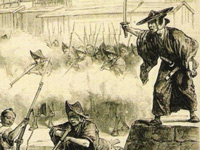
RESOURCES
This article uses material from the Wikipedia article "Boshin War (1868-1869)", which is released under the Creative Commons Attribution-Share-Alike License 3.0.
© Stories Preschool. All Rights Reserved.
